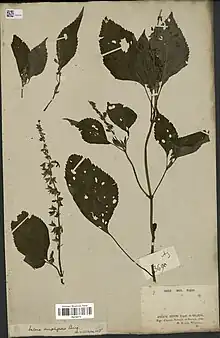| Salvia amplifrons | |
|---|---|
 | |
| Scientific classification | |
| Kingdom: | Plantae |
| Clade: | Tracheophytes |
| Clade: | Angiosperms |
| Clade: | Eudicots |
| Clade: | Asterids |
| Order: | Lamiales |
| Family: | Lamiaceae |
| Genus: | Salvia |
| Species: | S. amplifrons |
| Binomial name | |
| Salvia amplifrons | |
Salvia amplifrons is an annual or short-lived perennial herb that is endemic to Bolivia, growing at 2,650 to 3,000 metres (8,690 to 9,840 ft) elevation in forest shade on moist ground.
S. amplifrons grows upright to 30 to 60 centimetres (0.98 to 1.97 ft), with ovate or ovate-elliptic leaves that are 5 to 12 cm (2.0 to 4.7 in) by 3.5 to 8 cm (1.4 to 3.1 in). The inflorescence is a terminal raceme with about 6-flowered verticillasters, up to 10 cm (3.9 in) long. The 12 to 15 mm (0.47 to 0.59 in) corolla is white with slight blue flushing.[1]
Notes
This article is issued from Wikipedia. The text is licensed under Creative Commons - Attribution - Sharealike. Additional terms may apply for the media files.